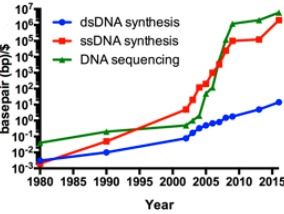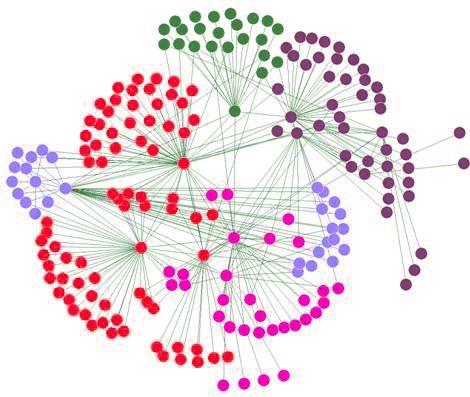““This poses a threat to whether the ‘right to be forgotten’ can be maintained in the long term,” said Keith Ross, the dean of engineering and computer science at N.Y.U. Shanghai who led the project and who said he had contacted Google with his research.”
SRI is developing wearable “exosuits” that can augment the musculoskeletal system for performance and strength enhancement and assistance to overcome or prevent damage from injury or disease. SRI’s exosuit differs from exoskeletons by using new muscle-like actuation, comfortable and soft skin attachment, and electronically releasable spring elements to minimize mass, bulk, and noise as well as eliminate constraints on natural joint motions. As part of DARPA’s Warrior Web Program, the technology is being applied to prevent and reduce musculoskeletal injuries caused by dynamic events typically found in the warfighter’s environment. They are exploring other military applications and beginning to use the technologies to assist individuals with musculoskeletal diseases.
The wearable exosuit, Superflex, uses motion sensors, accelerometers and gyroscopes to read the speed and angles of the owner’s legs and adjust its movements accordingly.
On April 21, 2016 – SRI International announced the launch of Superflex, Inc., its newest spin-off venture. Superflex will develop cutting-edge wearable robotics to enhance the human musculoskeletal system for a wide range of applications.
There are various animals that can live for centuries or millenia.
Genetic engineering technology is rapidly improving and genome wide genetic engineering could become a reality within 10–20 years. It could be possible to replicate in humans the longevity genes and cancer immunity in certain animals.
The longest lived mammal is the bowhead whales. Some confirmed sources estimate bowhead whales to have lived at least to 211 years of age.
Leading genomics experts have announced Genome Project-write (HGP-write), which aims to synthesize entire genomes of humans and other species from chemical components and get them to function in living cells.
As explained in Science, the goal of HGP-write is to reduce the costs of engineering large genomes, including a human genome, and to develop an ethical framework for genome-scale engineering and transformative medical applications.
Space is not the soundless vacuum movies would have us believe. In fact, judging by these eerie recordings of the music being thrown off by the oldest stars in the Milky Way, space actually sounds like a bit of a party.
The recordings were created by a team of scientists led by Andrea Miglio of the University of Birmingham, using data from NASA’s Kepler missions. After measuring the acoustic oscillations of some of the furthest known distant stars in the Milky Way’s M4 star cluster, the researchers were able to use that data to recreate the sounds and get an idea of just what noises the stars are throwing off. It’s a cacophony, for sure—but a surprisingly musical one that could slide pretty seamlessly into an ambient house track of your choice. (Free idea, DJs.)
Besides being excellent listening, the sounds are also scientifically useful. Measuring the tones from each star let the researchers derive a formula, which they’ve published today in Monthly Notices of the Royal Astronomical Society, to get more precise measurements of star masses and ages. Since the stars are so old, in some cases up to 13 billion years, researchers hope to use the sounds to get even more information about what the universe was like way back then.
Wow!
Mobile phone data may reveal an underlying mathematical connection between how we move and how we communicate that could make it easier to predict how diseases—and even ideas—spread through a population, according to an international team of researchers.
“This study really deepens our quantitative understanding of human behavior,” said Dashun Wang, assistant professor of information sciences and technology, Penn State. “We would like to think that we control our own behavior and we can do what we want to do. But, what we are starting to see with big data is that there is a very deep regularity underlying much of what we do.”
In a study, location and communication data collected from three international mobile phone carriers showed that people move and communicate in predictable patterns, said Wang.
America Future Secrets Military Weapons #Mind Blow (Full Documentary)
MOST FEARED Weapons Technology for US Military (Message to world) 2016.
This Documentary contains related tags:
The Top Secret World of Killing Weapons New (Full Documentary),history, documentary, secret,
Too funny; 2 days ago the article was that Musk feared the future of Singularity and Cyborgs; now he believes that we should become cyborgs. Musk needs to make his mind up; however, I am beginning to wonder about him.
Related: Elon Musk thinks we’re basically living in the Matrix, and we should be glad about it
This week, in a conversation at Recode’s annual Code Conference, Musk shared a tentative idea for something called “neural laces,” which he imagines could mitigate the risk of humanity becoming something of a pet to superintelligence.
“The solution that seems maybe the best one is to have an AI layer,” he said. “So think, if you have your limbic system, your cortex, and then a digital layer — sort of a third layer, above the cortex — that could work well and symbiotically with you. Just as your cortex works symbiotically with your limbic system, this digital layer would work symbiotically with the rest of you.”
Interesting twist; wonder how many tax dollars paid for the experts?
There is a bitter truth for economists, as well as professionals in other areas. Non-experts are typically better at forecasting future trends than experts.
It has been argued that economists should be historians rather than meteorologists and many years before the recent economic crash, John Kenneth Galbraith, the late Harvard economist, joked: “The only function of economic forecasting is to make astrology look respectable.”
Justin Wolfers, an economist, wrote last Friday in the New York Times on the May US jobs report which showed job creation falling to a net 38,000 in the month:









